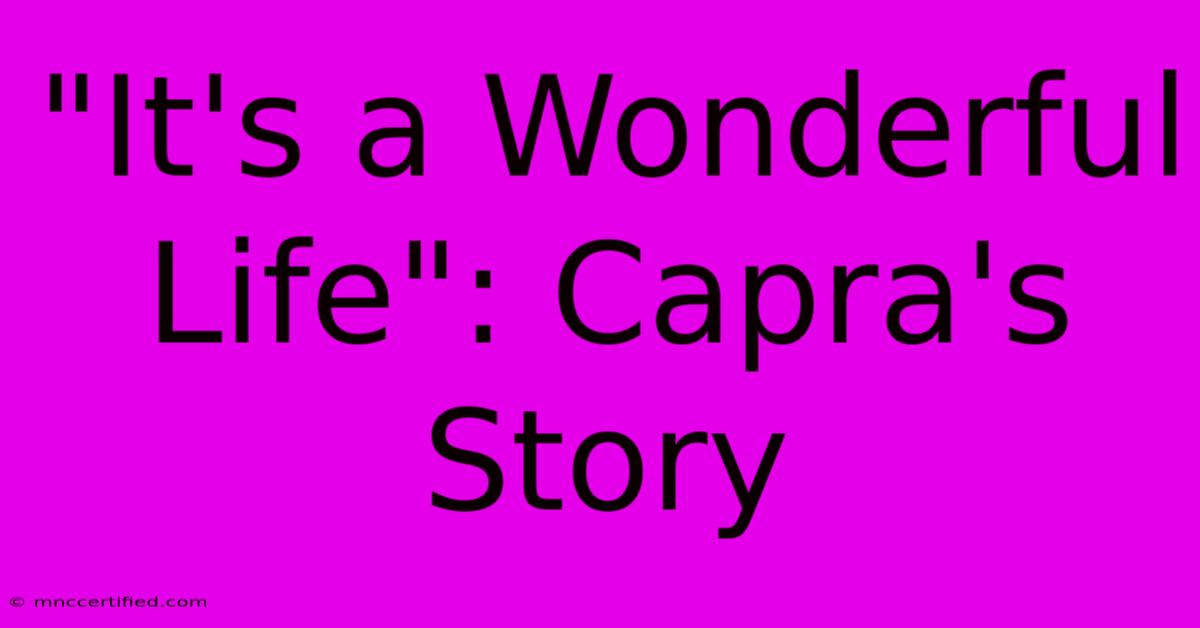"It's A Wonderful Life": Capra's Story

Table of Contents
It's a Wonderful Life: Frank Capra's Timeless Masterpiece
Frank Capra's It's a Wonderful Life (1946) transcends its status as a holiday classic; it's a profound exploration of human value, the importance of community, and the enduring power of hope. This article delves into the film's creation, its enduring legacy, and the reasons why it continues to resonate with audiences across generations.
The Genesis of a Classic: Capra's Vision
The film's origins lie in Philip Van Doren Stern's short story, "The Greatest Gift," a tale of a man contemplating suicide who's shown what life would be like without him. Capra, a director known for his populist and emotionally resonant films, saw immense potential in the story, recognizing its inherent message of human interconnectedness. He meticulously crafted the screenplay, infusing it with his signature blend of sentimentalism and social commentary.
More Than Just a Christmas Movie: Exploring Deeper Themes
While often categorized as a Christmas movie, It's a Wonderful Life tackles far more complex themes. It's a powerful commentary on:
- The American Dream: George Bailey's struggles to achieve his dreams, juxtaposed against the allure of a life less ordinary, reflect the challenges and compromises faced in pursuing the American ideal.
- The Value of Community: Bedford Falls, with its vibrant community spirit, stands in stark contrast to the soulless Pottersville. Capra highlights the importance of neighbourly support and collective responsibility.
- The Power of Faith and Hope: Despite facing overwhelming adversity, George's unwavering faith in himself and his community ultimately prevails, showcasing the transformative power of hope in the face of despair.
- The Meaning of Life: The film's central question – "What is the meaning of my life?" – is explored through George's journey of self-discovery, ultimately concluding that even seemingly ordinary lives hold immense significance.
The Enduring Legacy: Why It's a Wonderful Life Remains Relevant
It's a Wonderful Life continues to captivate audiences due to its timeless themes and enduring message. Its relevance stems from the fact that its core message – the importance of human connection and the impact we have on others – remains universally resonant.
A Cultural Touchstone: Its Impact on Society
The film's enduring popularity is evident in its constant re-airings during the holiday season and its pervasive influence on popular culture. The phrase "Every time a bell rings..." has become synonymous with the film's magic, solidifying its place in the cultural lexicon.
Behind the Scenes: The Making of a Masterpiece
The production of It's a Wonderful Life wasn't without its challenges. The film faced initial box office disappointment, likely due to its release post-World War II and competition from other big-budget productions. However, its subsequent rise to prominence showcases the power of word-of-mouth and the enduring appeal of its heartwarming story.
Capra's Directorial Style and its Impact
Capra's masterful direction, combined with the stellar performances of Jimmy Stewart and Donna Reed, brought the story to life. His ability to blend sentimentality with social commentary remains a hallmark of his filmmaking style.
Conclusion: A Timeless Classic
It's a Wonderful Life is more than just a feel-good holiday movie. It's a powerful and enduring testament to the human spirit, the importance of community, and the enduring power of hope. Its continued relevance across generations reinforces its status as a true cinematic masterpiece and a testament to Frank Capra's visionary storytelling. Its themes resonate deeply with audiences today, reminding us of the significance of our actions and the impact we have on the world around us. It remains a timeless classic, deserving of its place among cinema's greatest achievements.

Thank you for visiting our website wich cover about "It's A Wonderful Life": Capra's Story. We hope the information provided has been useful to you. Feel free to contact us if you have any questions or need further assistance. See you next time and dont miss to bookmark.
Featured Posts
-
Brief American Airlines Halt In Atlanta
Dec 25, 2024
-
Open Casinos Christmas Ms Gulf Coast
Dec 25, 2024
-
Next Mega Millions Lottery Date
Dec 25, 2024
-
Home Alone Casting Snl Stars Near Miss
Dec 25, 2024
-
Eiffel Tower Evacuated Fire Alarm
Dec 25, 2024